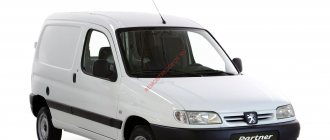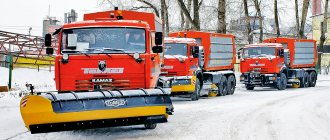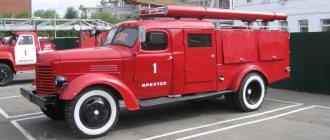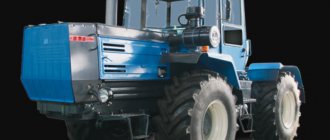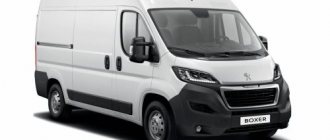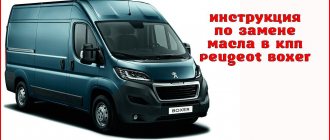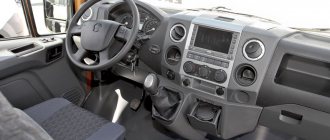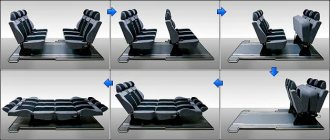Peugeot Boxer van. Photo by Groupe PSA
Peugeot Boxer is a commercial van designed by the Fiat Centro Stile design bureau. Produced by a joint venture of the joint venture Sevel SpA , created in 1978 by the Italian Fiat Group and the French PSA Peugeot Citroën. modern design in 2006. It is produced under four brands : Peugeot Boxer, Citroen Jumper, RAM Promaster (in the USA) and the third generation Fiat Ducato III. Factories are located in Italy, France, and Russia. Based on a commercial van, light-duty trucks and buses for various purposes are produced.
Detailed description, device, modifications
The Peugeot Boxer bus is presented in two modifications: minibus (city) and tourist/intercity.
A bus based on Peugeot Boxer in versions for minibuses is capable of transporting from 9 to 22 people (not counting the driver) in full compliance with the requirements of GOST R 41.52-2001 .
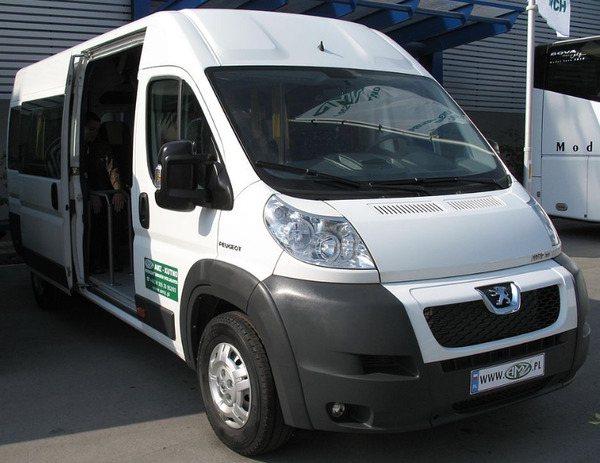
Peugeot Boxer bus. Photo Wikipedia
This was achieved thanks to the advantageous difference between the Peugeot Boxer and its classmates in terms of internal body height - this car can carry standing passengers! If we take into account that drivers, in violation of all norms, “ram” passengers during rush hours, then 22 people is far from the capacity limit for the Peugeot Boxer. In addition, the presence of a wide free passage in the cabin can be used to accommodate luggage on routes serving train stations and airports.
When manufacturing buses based on Peugeot Boxer, only those technologies are used that have proven themselves in operation on other minibuses:
- In finishing the ceiling and side surfaces, materials are used that are not subject to temperature deformation and dampen noise.
- The floor manufacturing technology does not violate the integrity of the galvanized bottom of the car with fasteners, and all seams are additionally sealed.
- The flooring allows you to clean the interior using a jet of water under pressure.
- All new materials used in the construction of Peugeot Boxer buses undergo laboratory testing, road tests on a specific sample and are certified.
Options for the Peugeot Boxer include passenger compartment air conditioning, automatic climate control, auxiliary air heater, engine pre-heater, audio-video equipment, seats of various configurations, a range of finishing materials and much, much more.
The body layout of the Peugeot Boxer, having the advantages of maximum safety and controllability, allows the carrier to win not only in the number of passengers, but also in reducing the time spent on boarding and disembarking.
One of the advantages of the Peugeot Boxer is the cab-forward half-hood layout . This arrangement gives the Peugeot Boxer a number of very important properties:
- For an empty and a fully loaded car, the weight distribution along the axes remains almost the same.
- Increased capacity in the passenger compartment and/or cargo compartment.
If you look at the Peugeot Boxer from the side, you will notice that the spacious and roomy cabin is slightly shifted forward, and the engine compartment is very small. Everything is explained simply - the engine is placed across the body and the drive is carried out on the front axle, so the engine compartment is very compact . At the same time, excellent access to the engine compartment for servicing the units is maintained. There is no driveshaft, and all the design disadvantages characteristic of rear-wheel drive.
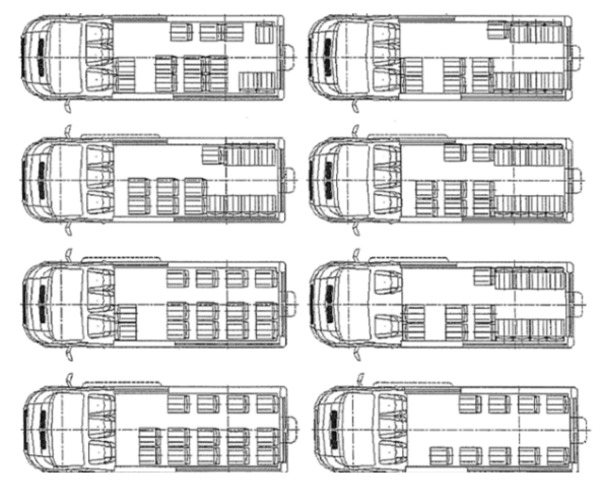
Peugeot Boxer bus interior diagrams. Photo by Groupe PSA
In the Peugeot Boxer, this arrangement made it possible to lower the floor level of the passenger compartment - the car's center of gravity became lower, and its position, depending on the load, was almost unchanged. Thanks to this, the road stability even at maximum loads makes the Peugeot Boxer one of the best in its class. This property distinguishes the Peugeot Boxer from most of its classmates, whose engines are located longitudinally and the drive is carried out on the rear axle.
Peugeot Boxers are famous for their safe handling and cross-country ability , especially in winter. Unlike cars with rear axle drive, Peugeot Boxer gives drivers much less problems with wheel slipping when driving on slippery roads or when maneuvering on icy areas. The driver will not have to waste the precious time and nerves of passengers on extracting his car from ice captivity. Let's add here another advantageous feature - the Peugeot Boxer has better cross-country ability in winter thanks to single-pitch rear wheels.
In slushy and deep snow, the front and rear wheels of the Peugeot Boxer travel “track after track”, without creating unnecessary resistance and prerequisites for slipping, which is often observed in “dual-slope” competitors.
In summer, the Peugeot Boxer single tire significantly saves fuel and makes driving more comfortable.
The Peugeot Boxer Tourist bus is designed for intercity transportation, and can also be used for sightseeing and tourist trips. It features comfortable seats with adjustable backrest angle, folding armrest and seat belt. For the convenience of stowing hand luggage, luggage racks . The passenger compartment is decorated with high-quality materials and is equipped with an air conditioning system.
Peugeot Boxer buses were designed to meet stringent European requirements for vehicle safety, reliability and efficiency. This car will change your idea of buses. European assembly, powerful diesel engine that meets Euro-4 environmental standards, modern, catchy and interesting appearance, no steps in the passenger compartment with the lowest floor level among competitors and a cabin height of more than 1,900 mm, front-wheel drive, reinforced suspension, disc brakes on all wheels, ABS and emergency braking assistance system and many other pleasant little things included in the basic package - all of these are endowed with the Peugeot Boxer.
Equipment
| Parameter or element of a converted interior | Minibus taxi | Suburb |
| Glazing | Full glazing of the body, safety glass tempered with “silk-screen printing” glued in, 2 windows, rubber seals, tinted from the glass supplier | |
| Interior trim with plastic panels | Availability | |
| Ceiling | Plastic/composite material | |
| Passenger compartment door trim | Standard plastic panels, Caps for the upper parts of the side sliding door and rear swing doors (gray plastic), Door window openings without plastic trims | |
| Number of seats in the cabin | 16 | 14 |
| Lap seat belt inserts | On 16 seats | |
| Ventilation escape hatch | One | |
| Filter-ventilation device (FVU) | One | |
| Flooring | Anti-slip, wear-resistant floor coating for the passenger compartment | |
| Electric sliding door drive | Eat | – |
| Interior lighting | Three LED lamps | |
| Salon handrails at the sliding door and ceiling | Eat | |
| Thermal and noise insulation of the interior | Stizol | |
| Passenger seats | Passenger seats with fabric upholstery | Soft upholstered seats, high backrests with folding armrests along the aisle, reclining backrests, 3-point seat belts |
| Interior heater | 1 pc., with an additional pump and shut-off valve for a winter-summer water heater system | Autonomous interior heater (at least 3.9 kW) with wiring along the podium |
| Driver signal button | Two buttons | |
| Side stand | One | |
| Glass breaking hammer | One | |
| Low partition with lampshade | One | |
| Device against accidental opening of emergency exit | Belt block on rear swing doors – 1 pc. | – |
| Salon mirror | One | – |
| Outline lights | One | – |
Restyling of Peugeot Boxer 2014
The most noticeable external difference of the restyled Peugeot Boxer is the new front end. In headlights that are completely different in shape, you can now find LED running lights (although in the “base” this is an additional option). The old radiator grille has been retouched, and the bumper has changed slightly. The interior of the car has received updated basic upholstery in black fabric, with gray and orange splashes.
The car's strength and sound insulation have been improved through strengthening the body structure and innovative, more durable rear and side door mechanisms. The braking system has been improved with larger brake discs with improved performance and sound insulation. Shock absorbers of an updated design have appeared - with protection against the ingress of foreign objects.
The more modern standard multimedia system is equipped with CD, MP3, USB, AUX outputs, Bluetooth connectivity, a 5-inch touch screen and steering wheel audio controls.
Refinement of the car for sale in Russia has continued: now the standard equipment includes a metal crankcase protection, a non-programmable Webasto heating optimization system (5 kW), a 12V socket in the cargo compartment, as well as a high-capacity battery (110 Ah) and mirrors rear view with electric drive and electric heating.
In general, the modernized Peugeot Boxer has become more modern and technologically advanced, adding standard equipment (there is now ESP, a driver's airbag, and power windows), and retaining almost all of its advantages already familiar to consumers.
Basic information, characteristics
- Manufacturer/manufacturer where the equipment is produced/manufactured. Sevel is the common name of two factories created jointly by PSA Peugeot Citroën (the name from 2020 is Groupe PSA) and Fiat, as well as the cars produced by these factories. The Sevel Sud plant was founded in accordance with an agreement signed by PSA and Fiat in 1978.
- Purpose. City, suburban, tourist, intercity, excursion, special, school, ritual.
- Class. Small.
- Body type. Load-bearing body, which is made with extensive use of high-strength steel.
Peugeot Boxer transmission
The engine is mated to a six-speed manual gearbox “MLGU6”. The gear shift lever is located on the tide of the center console, directly under the right hand. Its strokes are short and the switching is clear, which is not the case with all trucks. The transmission gear ratios are well chosen: the “step” between first and second gears is not too large, and when shifting up, the engine does not fall into the turbo hole. This helps in traffic jams. At the same time, sixth gear always remains working: the engine in it, even with a full load, does not go out on climbs, requiring a downshift, but pulls calmly.
Isothermal van on Peugeot Boxer chassis
The first gear is very short, it is needed only for starting from a standstill. Then the second one immediately “asks”, which, apparently, is designed to fully load the car. Theoretically, without a load, you can immediately use second gear, and first gear is only needed when loaded
Chasis (chassis with welded cab); Fourgon (all-metal cargo van); Combi (all-metal cargo-passenger van), passenger minibus.
The decoding of the alphanumeric designations of machine modifications is as follows:
- Body type: ChC – chassis + cab; FT – all-metal van.
- Gross weight: 330 – 3 t; 333 – 3.3 t; 335 – 3.5 t; 440 – 4 t.
- Cargo compartment length: L1 – 2,670 m (standard); L2 – 3.12 m (average); L3 – 3.705 m (long); L4 – 4.07 m (extra long).
- Maximum cargo (roof) height: H1 – 1.662 m (standard); H2 – 1.932 m (average); H3 – 2.172 m (high).
- 2 HDI 130 – means “diesel engine with a volume of 2.2 liters and a power of 130 hp.”
On add-ons, Peugeot-Citroen Rus mainly cooperates with Ryazan. Also certified are Mytishchi Instrument-Making Plant in Nizhny Novgorod, GIRD from the city of Miass, Chelyabinsk Region, and Techpro from Obninsk. Their add-ons vary in design and price. Retail prices are indicated on the manufacturers' websites. Their product line is the same: flatbed (with or without awning), manufactured goods van and isothermal van. The design and materials, and, consequently, the cost characteristics are selected based on the buyer’s requests and his ability to pay.
Engine/powertrain characteristics
- Type. Diesel.
- Number and arrangement of cylinders. 4, in-line.
- Environmental safety standards. Euro-4.
- Working volume, l. 2,2.
- Engine power, hp/min. 130.
- Maximum torque, Nm/min. 320 at 2000 rpm.
- Engine location. Transverse.
- Checkpoint. 6-speed manual transmission.
- Front-rear axle suspension. The front wheels of the vehicle are suspended by means of an independent MacPherson-type suspension with anti-roll bar, and the rear wheels are suspended by a dependent design with hydraulic shock absorbers and leaf springs.
Peugeot Boxer 1
1994 was the premiere year for the Peugeot Boxer. Initially produced as a light-duty truck, van, chassis, minibus. Until 2006, the model did not undergo significant changes. Characteristic features of the first Boxer family:
- five-speed high-reliability transmission, manual or 4-speed automatic;
- independent suspension of a lever-spring system located at the front, at the rear - a dependent arrangement with longitudinal springs;
- transverse arrangement of the motor;
- it is based on a powerful frame-body load-bearing chassis;
- rack and pinion steering system.
In terms of external characteristics, the overall dimensions of the Peugeot Boxer were somewhat different from their second-generation counterparts:
- height varies from 215 to 286 cm;
- length 475–560 cm;
- the width is slightly more than 202 cm;
- the distance between the axles of the front and rear wheels is from 285 to 370 cm.
The weight of the Boxer in its various modifications is 2900–3500 kg.
At the beginning of the 2000s, the Boxer was slightly modernized. The exterior has become different: block headlights have been installed, the front bumper and mirrors have been enlarged, and plastic moldings have been added. The interior design has changed slightly. Among the changes in the power unit: 2.3 liter engines, 16 valves, 128 hp appeared. and 2.8 liters with 146 hp, but the 1.9 liter diesel engine was discontinued.
Equipment
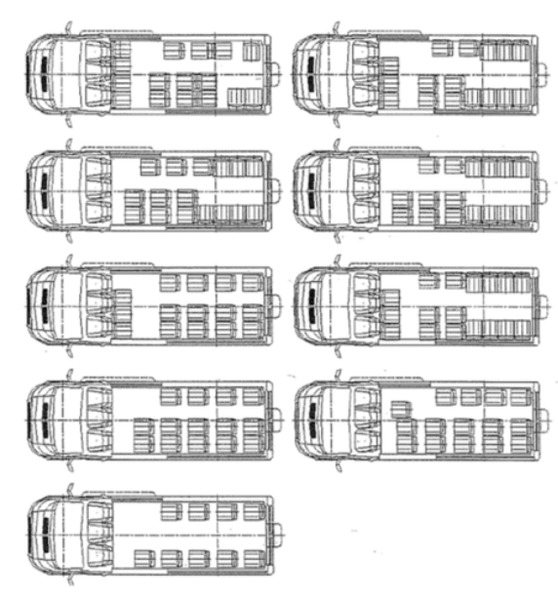
Possible layouts of a refurbished interior. Photo by Groupe PSA
Route taxi:
- Full body glazing
- Thermal and noise insulation of the interior
- Interior trim with plastic panels
- Fabric ceiling trim
- Ventilation escape hatch
- Filter and ventilation device
- Floor finishing with anti-slip coating
- Electric sliding door drive
Tourist:
- Full body glazing
- Interior trim with plastic panels
- Anti-slip, wear-resistant interior floor covering
- Interior heater powered by a 4kW cooling system.
- Three LED lamps
- Air conditioner
- Side stand
- Salon handrails at the sliding door
- Curtains on the windows
- Thermal and noise insulation of the interior
- Sliding door drain
- Glass breaking hammer
- Handle on the sliding door on the interior side
